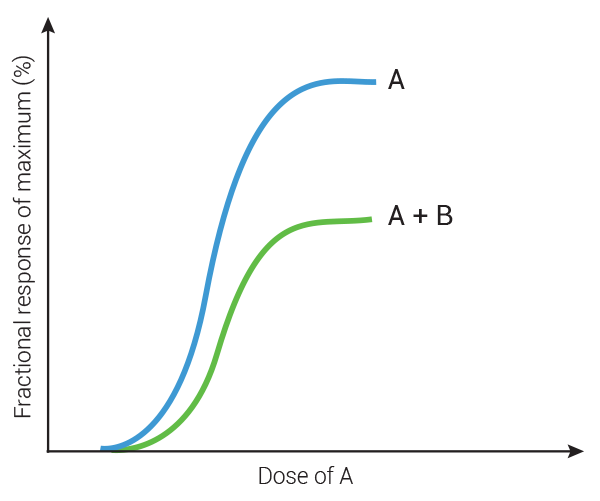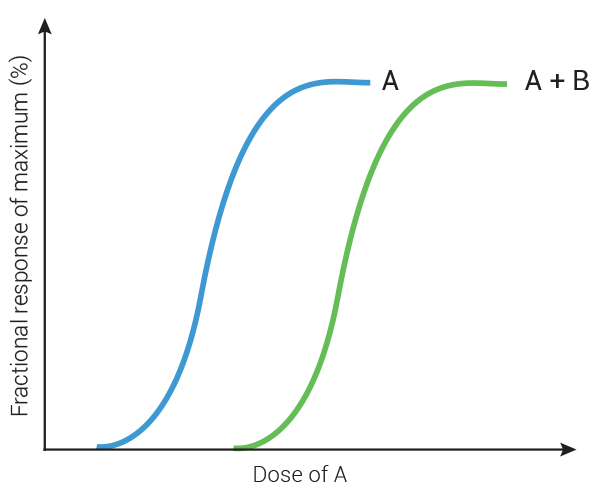WBR0902: Difference between revisions
Jump to navigation
Jump to search
Sergekorjian (talk | contribs) No edit summary |
Sergekorjian (talk | contribs) No edit summary |
||
| Line 25: | Line 25: | ||
[[File:WBR0902.png|450px]] | [[File:WBR0902.png|450px]] | ||
|Explanation=Efficacy is defined as the maximal effect a drug can produce. While a full agonist produces a maximal effect, a partial agonist can only produce a fraction of that effect i.e. has a lower efficacy. The figure demonstrates that when A is administered alone, a maximal response is observed. However, when A and B are combined, the curve is shifted downwards signifying a decrease in efficacy. The dose response curve demonstrates that the response reaches a plateau and does not increase despite an increase in the dose of drug A. This is the classical effect of a non-competitive inhibitor causing an irreversible decrease in efficacy. Phenoxybenzamine is a non-competitive inhibitor of norepinephrine that fits the dose-response curve displayed. | |Explanation=Efficacy is defined as the maximal effect a drug can produce. While a full agonist produces a maximal effect, a partial agonist can only produce a fraction of that effect i.e. has a lower efficacy. The figure demonstrates that when A is administered alone, a maximal response is observed. However, when A and B are combined, the curve is shifted downwards signifying a decrease in efficacy. The dose response curve demonstrates that the response reaches a plateau and does not increase despite an increase in the dose of drug A. This is the classical effect of a non-competitive inhibitor causing an irreversible decrease in efficacy. Phenoxybenzamine is a non-competitive inhibitor of norepinephrine that fits the dose-response curve displayed. | ||
Had drug B been a competitive antagonist, the effect would have been observed as a decrease in potency not in efficacy. This signifies a relative decrease in efficacy at a certain dose that can be overcome by increasing the dose. the dose response curve would resemble the one shown below. | |||
[[Image:Dose-responseNCA.png|450px]] | |||
|AnswerA=Naloxone and morphine | |AnswerA=Naloxone and morphine | ||
|AnswerAExp=Naloxone is a competitive antagonist of morphine. When a competitive antagonist is present, the potency of the agonist is altered and the curve of the effect of the agonist by increasing dose will be shifted towards the right. | |AnswerAExp=Naloxone is a competitive antagonist of morphine. When a competitive antagonist is present, the potency of the agonist is altered and the curve of the effect of the agonist by increasing dose will be shifted towards the right. | ||
| Line 36: | Line 40: | ||
|AnswerEExp=Phenoxybenzamine is a noncompetitive inhibitor of norepinephrine. An increase in the concentration of norepinephrine is not able to overcome the effect of phenoxybenzamine. | |AnswerEExp=Phenoxybenzamine is a noncompetitive inhibitor of norepinephrine. An increase in the concentration of norepinephrine is not able to overcome the effect of phenoxybenzamine. | ||
|EducationalObjectives=Phenoxybenzamine is a noncompetitive inhibitor of norepinephrine that causes a decrease in its efficacy. | |EducationalObjectives=Phenoxybenzamine is a noncompetitive inhibitor of norepinephrine that causes a decrease in its efficacy. | ||
|References=Lambert, DG. Drugs and receptors. Contin Educ Anaesth Crit Care Pain. 2004;4(6): 181-4 | |||
|RightAnswer=E | |RightAnswer=E | ||
|WBRKeyword=Antagonist, Competitive antagonist, Non-competitive antagonist, Phenoxybenzamine, Norepinephrine, | |WBRKeyword=Antagonist, Competitive antagonist, Non-competitive antagonist, Phenoxybenzamine, Norepinephrine, | ||
|Approved=Yes | |Approved=Yes | ||
}} | }} | ||
Revision as of 20:43, 9 March 2015
| Author | [[PageAuthor::Rim Halaby, M.D. [1] (Reviewed by Serge Korjian)]] |
|---|---|
| Exam Type | ExamType::USMLE Step 1 |
| Main Category | MainCategory::Pharmacology |
| Sub Category | SubCategory::General Principles |
| Prompt | [[Prompt::A researcher is investigating the effects of two drugs, A and B, for blood pressure reduction in rats. The graph below is the dose-response curve of drug A when administered alone or when co-administered with drug B. Which of the following combinations has similar curve to that of A and B combined? |
| Answer A | AnswerA::Naloxone and morphine |
| Answer A Explanation | AnswerAExp::Naloxone is a competitive antagonist of morphine. When a competitive antagonist is present, the potency of the agonist is altered and the curve of the effect of the agonist by increasing dose will be shifted towards the right. |
| Answer B | AnswerB::Atropine and acetylcholine |
| Answer B Explanation | AnswerBExp::Atropine is a competitive antagonist of acetylcholine. When a competitive antagonist is present, the potency of the agonist is altered and the curve of the effect of the agonist by increasing dose will be shifted towards the right. |
| Answer C | AnswerC::Haloperidol and dopamine |
| Answer C Explanation | AnswerCExp::haloperidol is a competitive antagonist of dopamine. When a competitive antagonist is present, the potency of the agonist is altered and the curve of the effect of the agonist by increasing dose will be shifted towards the right. |
| Answer D | AnswerD::Ondansetron and serotonin |
| Answer D Explanation | AnswerDExp::Serotonin is a competitive antagonist of ondansetron. When a competitive antagonist is present, the potency of the agonist is altered and the curve of the effect of the agonist by increasing dose will be shifted towards the right. |
| Answer E | AnswerE::Noreprinephrine and phenoxybenzamine |
| Answer E Explanation | AnswerEExp::Phenoxybenzamine is a noncompetitive inhibitor of norepinephrine. An increase in the concentration of norepinephrine is not able to overcome the effect of phenoxybenzamine. |
| Right Answer | RightAnswer::E |
| Explanation | [[Explanation::Efficacy is defined as the maximal effect a drug can produce. While a full agonist produces a maximal effect, a partial agonist can only produce a fraction of that effect i.e. has a lower efficacy. The figure demonstrates that when A is administered alone, a maximal response is observed. However, when A and B are combined, the curve is shifted downwards signifying a decrease in efficacy. The dose response curve demonstrates that the response reaches a plateau and does not increase despite an increase in the dose of drug A. This is the classical effect of a non-competitive inhibitor causing an irreversible decrease in efficacy. Phenoxybenzamine is a non-competitive inhibitor of norepinephrine that fits the dose-response curve displayed.
Had drug B been a competitive antagonist, the effect would have been observed as a decrease in potency not in efficacy. This signifies a relative decrease in efficacy at a certain dose that can be overcome by increasing the dose. the dose response curve would resemble the one shown below.
|
| Approved | Approved::Yes |
| Keyword | WBRKeyword::Antagonist, WBRKeyword::Competitive antagonist, WBRKeyword::Non-competitive antagonist, WBRKeyword::Phenoxybenzamine, WBRKeyword::Norepinephrine |
| Linked Question | Linked:: |
| Order in Linked Questions | LinkedOrder:: |

